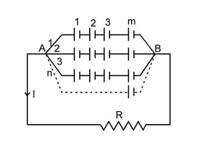
The arrangement of electrical cells in different configurations is the basic step for optimising electrical circuits for different applications. We will be examining three primary methods of grouping cells—series, parallel, and multiple arc arrangements, as well as their distinct advantages depending on circuit requirements. When cells are connected in these different configurations, their combined electromotive force (EMF) and internal resistance follow specific mathematical relationships that determine the overall circuit performance. After understanding these arrangements, it becomes easy to select the most efficient arrangement based on external resistance values and desired current output. The following sections provide a detailed analysis of each configuration, including relevant formulas, diagrams, and conditions for optimal performance. The CBSE Board and other entrance exams like NEET and JEE contain questions based on the NCERT concepts which is why the topic is a part of current electricity and NCERT solutions can help in understanding tricky questions related to this topic.
- What is a Cell?
- Cells in Series :
- Working Principle of Cell in Series
- Practical Applications of Cell in Series
- Cells in Parallel:
- Practical Applications of Cell in Parallel
- Cells in Multiple Arc:
What is a Cell?
A cell or an electrochemical cell is a single-unit device that generates electrical energy through chemical reactions. There are two main types of electrochemical cells: including Galvanic/Voltaic or Electrolytic cells. An electrochemical cell consists of an anode and cathode (two electrodes), electrolyte solutions containing ions, a salt bridge/porous barrier and an external circuit that connects the electrodes in galvanic cells.
Please note:
Three questions are asked from Current Electricity chapter which includes a topic on Combination of cells in series and parallel. It is important to have a thorough understanding of the chapter from JEE exam point of view.
Cells in Series :
Equivalent EMF
Equivalent internal resistance
If
cells each of emf
, arranged in series and if
is internal resistance of each cell, then total emf
so current in the circuit
If
then
Series combination is advantageous.
If
then
Series combination is not advantageous.
Note : If polarity of
cells is reversed, then equivalent emf
while the equivalent resistance is still
, so current in
will be
Working Principle of Cell in Series
When you put electrochemical cells in series, the following happens:
1. EMFs Add Up
Each cell has its own open-circuit voltage (EMF) 𝐸. When cell are put in series combination, the total EMF is the sum:
E total = E1 + E2 +⋯+En
So three 1.5 V cells in series will result in 4.5 V at the terminals.
2. Internal Resistances Will Add Up
Every cell has a little internal resistance 𝑟. In series, these resistance will add up.
𝑟total = 𝑟1 + 𝑟2 + ⋯+ 𝑟𝑛
That extra resistance slightly limits how much current you can draw.
3. When You Connect a Load
Once you attach a load 𝑅L, Kirchhoff’s loop law gives
The same current 𝐼 flows through every cell
Practical Applications of Cell in Series
The following industries use the combination of cell in series:
| Industry |
Use Case |
| Consumer Electronics |
|
| Automotive Industry |
|
| Renewable Energy |
|
Cells in Parallel:
[Use emf's with polarity]
If
cells each of emf
and internal resistance
be connected in parallel and if this combination is connected to an external resistance then equivalent emf of the circuit
.
Internal resistance of the circuit
.
and
.
If
then, parallel combination of cells is advantageous.
If
then, parallel combination of cells is not advantageous.
Practical Applications of Cell in Parallel
The following points explain the applications of cell in parallel:
| Industry |
Use Case |
| Consumer Electronics |
Smartphones and laptops use parallel cell configurations to increase battery capacity and support higher current demands without increasing voltage |
| Automotive Industry |
Electric vehicle battery packs combine parallel cell groups to increase current output and range while maintaining voltage requirements |
| Renewable Energy |
Home battery storage systems connect cells in parallel to increase energy storage capacity and handle peak loads |
| Industrial Applications |
Data centers employ parallel battery arrangements in UPS systems to handle high current loads |
| Marine/RV |
Boats and recreational vehicles use parallel battery banks to extend runtime for onboard systems without changing system voltage |
| Telecommunications |
Cell towers and network equipment use parallel battery systems for extended backup power during outages |
| Medical Equipment |
Medical carts and portable equipment use parallel battery configurations for longer runtime between charges |
Cells in Multiple Arc:
number of identical cells.
number of rows
number of cells in each row.
The combination of cells is equivalent to single cell of
and internal resistance
Current
For maximum current
or
internal resistance of the equivalent battery.
Physics Current Electricity Exam
Student Forum
Other Topics under this Chapter
- Cells in Series and Parallel
- Kirchhoffs Law
- Ohms Law
- Wheatstone Bridge
- Overview
- Electric Current in Conductors
- Resistivity of a Material
- Limitations of Ohm's Law
- Electric Current
- Temperature Dependence of Resistivity
- Cells, EMF, Internal Resistance
- Electrical Energy and Power
- Drift of Electrons and the Origin of Resistivity
Other Class 12th Physics Chapters
- Physics Alternating Current
- Physics Ray Optics and Optical Instruments
- Physics Electromagnetic Induction
- Physics Dual Nature of Radiation and Matter
- Physics Semiconductor Devices
- Physics Wave Optics
- Physics Current Electricity
- Physics Nuclei
- Physics Electrostatic Potential and Capacitance
- Physics Atoms
- Physics Moving Charges and Magnetism
- NCERT Class 12 Notes
- NCERT Class 12 Physics
- Physics Electric Charge and Field
- Physics Electromagnetic Waves
- Physics Magnetism and Matter




